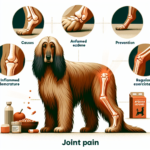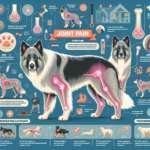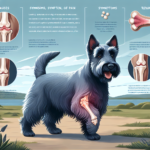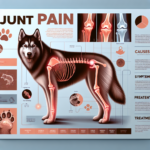Lhasa Apso Joint Pain: Causes, Symptoms, Prevention, and Treatment
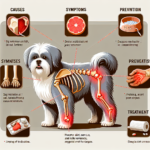
Introduction
The Lhasa Apso is a small, sturdy dog breed with a rich history that dates back over a thousand years. Originating from Tibet, these dogs were initially bred as sentinel dogs in Buddhist monasteries, alerting monks to any intruders. Known for their long, flowing coats and distinctive lion-like appearance, Lhasa Apsos are both charming and resilient. Despite their small size, they possess a confident and independent demeanor, making them excellent companions.
Like many purebred dogs, Lhasa Apsos are prone to certain health issues. Among these, joint pain is a significant concern that can affect their quality of life. Joint health is particularly crucial for Lhasa Apsos due to their active nature and the physical demands of their compact yet sturdy build. Understanding the causes, symptoms, prevention, and treatment of joint pain in Lhasa Apsos is essential for ensuring their well-being.
Breed-Specific Joint Pain Risks
Genetic Predisposition
Lhasa Apsos have a genetic predisposition to several joint-related issues, including hip dysplasia and patellar luxation. Hip dysplasia occurs when the hip joint does not fit together perfectly, leading to arthritis and pain over time. Patellar luxation, on the other hand, involves the dislocation of the kneecap, which can cause intermittent lameness and discomfort. These conditions are often inherited, making it crucial for breeders to screen for these issues.
Age-Related Risks
As Lhasa Apsos age, the risk of developing joint pain increases. Arthritis is a common age-related condition that affects many older dogs, including Lhasa Apsos. The breed typically shows signs of joint pain as they approach their senior years, around 7-10 years of age. Early detection and management are key to maintaining their mobility and comfort.
Activity Level and Joint Stress
Lhasa Apsos are known for their playful and energetic nature. While regular exercise is essential for their overall health, excessive or high-impact activities can put undue stress on their joints. Activities such as jumping from heights or running on hard surfaces can exacerbate joint issues, especially in dogs with a genetic predisposition to such problems.
Common Symptoms of Joint Pain in Lhasa Apsos
General Symptoms
- Limping or favoring one leg
- Stiffness, especially after rest
- Reluctance to climb stairs or jump
- Decreased activity or playfulness
- Visible discomfort or pain when touched
Breed-Specific Symptoms
In Lhasa Apsos, joint pain may manifest as a reluctance to engage in activities they once enjoyed, such as playing or going for walks. They may also exhibit a noticeable change in their gait, often appearing to “bunny hop” when running. Additionally, they might show signs of discomfort when being groomed or handled, particularly around the hips and knees.
When to Consult a Vet
If you notice any of the above symptoms in your Lhasa Apso, it is essential to consult a veterinarian promptly. Early intervention can prevent the progression of joint issues and improve your dog’s quality of life. Regular veterinary check-ups are also crucial for monitoring joint health and catching any problems early.
Preventive Measures for Joint Health
Exercise Recommendations
Regular, low-impact exercise is vital for maintaining joint health in Lhasa Apsos. Activities such as walking, swimming, and gentle play are excellent options. Avoid high-impact exercises like jumping or running on hard surfaces, as these can exacerbate joint issues. Aim for consistent, moderate exercise to keep your Lhasa Apso fit and healthy.
Dietary Suggestions
A balanced diet rich in essential nutrients can support joint health. Consider incorporating foods or supplements that contain glucosamine, chondroitin, and omega-3 fatty acids, which are known to promote joint health. Consult your veterinarian for specific dietary recommendations tailored to your Lhasa Apso’s needs.
Weight Management
Maintaining a healthy weight is crucial for reducing joint stress. Excess weight can exacerbate joint pain and lead to other health issues. Monitor your Lhasa Apso’s weight and adjust their diet and exercise routine as needed to keep them at an optimal weight. Your veterinarian can provide guidance on appropriate weight ranges and portion sizes.
Early Screening and Monitoring
Regular veterinary check-ups and early screening for joint issues can help catch problems before they become severe. Genetic testing for conditions like hip dysplasia and patellar luxation can inform breeding decisions and early intervention strategies. Additionally, monitoring your dog’s activity levels and behavior can provide early clues to potential joint issues.
Treatment Options for Joint Pain
Non-Surgical Treatments
Non-surgical treatments for joint pain in Lhasa Apsos include medications, physical therapy, and lifestyle adjustments. Anti-inflammatory medications and pain relievers can help manage symptoms, while physical therapy can improve mobility and strengthen muscles around the joints. Lifestyle adjustments, such as providing a comfortable bed and avoiding high-impact activities, can also alleviate joint pain.
Surgical Options
In severe cases, surgical intervention may be necessary. Common surgeries for joint issues in Lhasa Apsos include hip replacement, knee surgery for patellar luxation, and arthroscopy to remove damaged tissue. These procedures can significantly improve your dog’s quality of life, but they come with risks and require a thorough discussion with your veterinarian.
Alternative Therapies
Alternative treatments such as acupuncture, hydrotherapy, and massage can also benefit Lhasa Apsos with joint pain. Acupuncture can help reduce pain and inflammation, while hydrotherapy provides low-impact exercise that strengthens muscles without stressing the joints. Massage therapy can improve circulation and alleviate muscle tension, contributing to overall joint health.
Lifestyle and Management Tips
Daily Care Routine
A consistent daily care routine can help manage and alleviate joint pain in Lhasa Apsos. This routine might include gentle exercise, a balanced diet, and regular grooming to monitor for any signs of discomfort. Providing a comfortable, supportive bed and avoiding high-impact activities are also essential components of daily care.
Modifying the Home Environment
Making your home more comfortable for a dog with joint pain can significantly improve their quality of life. Consider installing ramps to help them navigate stairs or get onto furniture. Orthopedic beds provide additional support and comfort, while non-slip mats can prevent falls on slippery surfaces.
Long-Term Management
Long-term management of joint pain involves regular veterinary check-ups, consistent exercise, and a balanced diet. Monitoring your Lhasa Apso’s weight and adjusting their care routine as needed can help keep them active and happy despite joint pain. Additionally, staying informed about new treatments and therapies can provide more options for managing their condition.
FAQs About Lhasa Apsos and Joint Pain
What are the early signs of joint pain in Lhasa Apsos?
Early signs of joint pain in Lhasa Apsos include limping, stiffness, reluctance to move, and decreased activity levels. If you notice any of these symptoms, consult your veterinarian for a thorough evaluation.
Can joint pain in Lhasa Apsos be prevented?
While genetic predispositions cannot be entirely prevented, maintaining a healthy weight, providing regular low-impact exercise, and ensuring a balanced diet can significantly reduce the risk of joint pain. Early screening and monitoring can also help catch issues before they become severe.
Are there specific exercises that are better for Lhasa Apsos with joint pain?
Yes, low-impact exercises such as walking, swimming, and gentle play are ideal for Lhasa Apsos with joint pain. Avoid high-impact activities like jumping or running on hard surfaces, as these can exacerbate joint issues.
What dietary supplements can help with joint health in Lhasa Apsos?
Supplements containing glucosamine, chondroitin, and omega-3 fatty acids are known to support joint health. Consult your veterinarian for specific recommendations tailored to your Lhasa Apso’s needs.
When should I consider surgery for my Lhasa Apso’s joint pain?
Surgery should be considered when non-surgical treatments are no longer effective, and your dog’s quality of life is significantly impacted. Discuss the risks and benefits of surgical options with your veterinarian to make an informed decision.
Conclusion
Joint pain is a common concern for Lhasa Apsos, but with proper care and management, it is possible to maintain their quality of life. Understanding the causes, symptoms, prevention, and treatment options is essential for ensuring your Lhasa Apso’s well-being. Regular veterinary check-ups, a balanced diet, and appropriate exercise can go a long way in preventing and managing joint pain. By taking proactive measures and staying informed, you can help your Lhasa Apso live a happy, active life despite joint issues.

